In 1983, Tandy started designing a PC-compatible computer based on the IBM PC Jr.s enhanced sound and video, but combining it with the general standardization and expandibility of the original IBM PC and PC XT somewhat. When the IBM PC Jr. Flopped, Tandy quickly changed all their sales material to focus on the PC Compatibility of the 1000 rather than it's enhanced PC Jr derived feature set of enhanced CGA video and 3-voice audio when it was released in 1984. The Original Tandy 1000 was updated/revised in 1985 to the 1000A and 1000HD (a 1000A with a hard disk), through the 80's they had hit model after another such as the EX, SX, TX, HX, SL/x series, and TL/x series.
This is meant as a visual reference to the Tandy 1000 line of personal computers. Some external differences may exist. I'm using the pictures I have available to me. Hopefully this will help some retro-computing enthusiasts make decisions on what kind of "Tandy" they want. To me, the 1000 line is probably the bext PC/XT compatible line to pull from because of the enhanced features. They're not blazing fast by any stretch, actually the original 1000 is slower than an original IBM PC, but they are AMAZING for retro-gaming because of the enhanced sound and graphics, and a nice sized pool of PC Jr/Tandy compatible titles to play on them that make the experience that much better.
| Picture(s)
| Specifications
| Details
|
Tandy 1000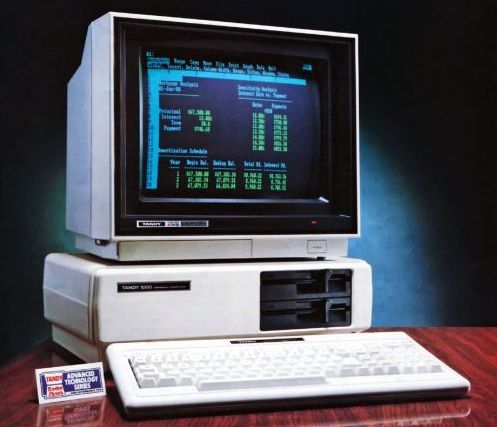
|
Released:1984
Class:PC/XT - Jr. Enh.
Form:Desktop, 3-Slot
CPU:i8088 @4.77 Mhz
ALU:n/a
RAM:256K, Expandable to 640K
FDD:One or two TEAC 360K DSDD 5.25"
HDD:External Option
EXP:3x ISA Slots
| The original Tandy 1000 was released in 1984 and is easily confused with it's upgraded counterpart, the Tandy 1000A as it's cosmetically identical. However there are some functional differences that are very important to note. First and foremost, there is no support on a original 1000 for a 8087 Math Co-Processor. Secondly, there is limited/no DMA on this version. It can only be told apart by the model# and the Motherboard itself, as the memory is located in the open space in front of the ISA slots. It shipped with MS-DOS 2.11 for the Tandy 1000 and the original release of Deskmate.
From my own personal assessment, the original 1000 is more a "collectors computer" than an actual "vintage user machine". It lacks support for DMA, and totally lacks support for an 8087, which contrary to common knowledge, is actually quite handy if you have an 8088, especially if it's your only retro-PC and you want to play something that uses it like a flight simulator or Sim City. I'm not poo pooing it by any stretch of the imagination but I am just letting you know there are better options out there for a XT-class retro PC.
|
Tandy 1000 A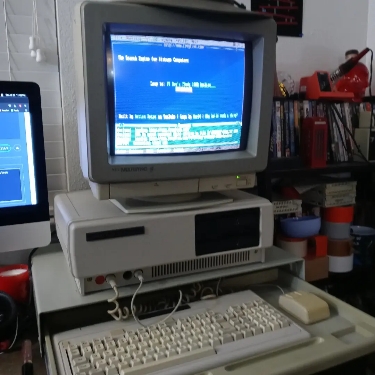
|
Released:1985
Class:PC/XT - Jr. Enh
Form:Desktop, 3-Slot
CPU:i8088 @4.77 MHz
ALU:i8087 Optional
RAM:256K, Expandable to 640K
FDD:One or two TEAC 360K DSDD 5.25"
HDD:External Option
EXP:3x ISA Slots
| The 1000A was a minor redesign of the original 1000. It is externally identical to the original 1000 and does not even have an "A" next to the 1000 on the front. It can only be told apart by the motherboard, as now the CPU and a socket for an 8087 Math Co-Processor is located close to the bottom left front of the case in front of the first ISA slot and the memory was inconveniently moved underneath the drive cage. Supposedly DMA was also added to this model to give a (minor) performance boost. It shipped also with MS-DOS 2.11 for the Tandy 1000 and Deskmate.
The Tandy 1000A is when I feel the series started getting good. The computer in the picture is my own personal 1000A and the one I've been flogging the hell out of for almost 15 years now. To me, this is the ideal XT-class machine for retro-gaming next to the 1000SX. It's got decent support for dual floppy drives, the space between the back of the floppies and the power supply make a good spot for a ghost XT-IDE hard disk installation, and the clips around the motherboard screws make for a really cool spot to put a "Knight Rider" effect HDD LED in for your XT-IDE card that shines through the air-vent without ruining airflow (not like an 8088 needs it much anyway. The only thing to watch out for is some BIOS versions have a problem with the NEC V20, and nobody has told me why. A 1000A with a V20, 8087, and a SmartWatch+ are a real beast of an XT machine, and EEVBLOG modded his to run at a faster clock speed so Overclocking is doable, and he has a schematic for it.
|
Tandy 1000 HD
|
Released:1985
Class:PC/XT - Jr. Enh
Form:AIO, 3-Slot
CPU:i8088 @4.77 MHz
ALU:?
RAM:256K Base, upgradable to 640K
FDD:One TEAC 360K DSDD 5.25"
HDD:10/20MB MFM Hard Drive
EXP:3x ISA Slots
| The 1000HD was basically a 1000A with a Hard Drive installed from the factory. It was released to compete with the IBM PC XT which had a 10MB HDD as standard equipment. These can be easily told from the 1000 and 1000A in that it does say "1000HD" on the front of the case, and probably a lot of people skipped the second floppy drive to save on the added cost of the hard disk. The Hard Disk is a large device that hangs under the drive cage just above the motherboard and is definatley an MFM or RLL model because it uses 2 cables. This model shipped with MS-DOS 3.0 for the Tandy 1000 HD + Deskmate.
Like I said about the 1000A, since it's pretty much the same machine, you can't really go wrong with an HD either, actually, the HD has provisions for a Hard Disk built in so you might be at some benefit. So it's a great XT-class gaming machine of the time as it's pretty much the same as the 1000A, just with a hard drive from the factory (which most likely is dead by now anyway). It seems Tandy did not sell too many of these and little surprise being as 2 years later an EXTERNAL HDD kit for the 1000SX was around $4000 for 40 Megabytes (that's $1000 a Megabyte Kiddos!). My how far we have come, you could cram a CF-CARD and Reader and an 8 GIGABYTE CF Card in this thing for about $3980 less today and have more space than you'd ever know what to do with.
|
Tandy 1000 EX
|
Released:1986
Class:PC/XT - Jr. Enh
Form:Desktop Wedge
CPU:i8088 @ 6MHz
ALU:?
RAM:384K, Expandable to 640K
FDD:1x 360K DSDD 5.25" TEAC
HDD:External Option
EXP:Plus-Card BUS x3
| The 1000EX was the $999 Budget verrsion of the 1000, taking some cues from the Atari ST and Commodore Amiga 500 stylistically with the wedge "All-in-One" except the monitor scheme. Electronically it's basically a Tandy 1000 SX, as it has a 6MHz 8088 CPU, can be upgraded to 640K RAM. The primary difference is a side roller for volume, headphone jack, one floppy drive (instead of two), and the special "Plus-Card Bus", which uses a series of electronically identical to ISA (and very long) pins to attach special "Plus Cards" into the Tandy for expansion. Some popualr options included a 640K memory board, and a 2400 baud modem. It also had a permanantly attached power cord vs. the standard IEC Power connector all the other Tandy models use. It shipped with MS-DOS 3.1 for the Tandy 1000 EX and Deskmate II as it's standard software bundle.
The 1000 EX would be a good machine if you are short on space, or want something you could setup in your livingroom like a game console or an older computer like the Commodore 64 or TRS-80 CoCo, because I think that's also what it was originally meant for as well. The EX is basically a downscaled Tandy 1000 SX minus one floppy drive but plus a volume control. The OpenSource hardware community today has made it a lot easier to upgrade these Plus-Card based Tandy models making them a more viable solution. A EX with a CF-Card for a HDD and an adapted in Ethernet Card could be a really nice system for someone who wants to play old DOS games and surf shareware BBSes in the 2020's.
|
Tandy 1000 SX
|
Released:1986
Class:PC/XT - Jr. Enh
Form:Desktop 5-Slot
CPU:i8088 @6MHz
ALU:i8087 Optional
RAM:384K, Expandable to 640K
FDD:One or two 360K DSDD TEAC 5.25"
HDD:Internal Hard-Card Offered
EXP:5x ISA Slots
| The 1000SX was the spiritual successor to the original 1000 and 1000A. It got a speed bump up to 6MHz, and two more ISA Slots added. Also the base RAM from the box was bumped up from 256K to 384K, and all 640K was now affixed to the motherboard (rather than 256K on the motherboard and 384K expansion on the ISA Bus via a card like the 1000/1000A/1000HD). The 1000 SX was a very popular model and seems to be the most sought after of the 8088-based Tandy 1000 models. This was also my first computer (in 1997 - that's right 97', not a mis-type). It shipped with MS-DOS 3.1 for the Tandy 1000 SX and Deskmate II + supplimental utilities for Deskmate on Floppy Disk.
Like I said, this was the original computer I owned and I did not recognize it's greatness as much as I do now because it's the computer I cut my teeth on computers with. The Tandy 1000 SX is basically a 6MHz Tandy 1000A, with 2 more expansion slots. That makes this one the best in the series IMHO, as there's no real benefit in having a Tandy in the 286 and later categories IMHO. It also is a pretty easy system to work on. I took mine completley apart and put it back together 100% many times in my teen years looking for ways to upgrade and improve the performance. So a 1000SX is really a fine machine for retro-gaming. There's a reason so many people sing the praises of the 1000SX. The only problem is the price on them has gone up because of this. Hence why I really flog the 1000HD and 1000A as well because they are pretty much teh same machine, just roughly 2MHz slower, and they tend to be more plentiful and inexpensive compared to the mighty 1000SX.
|
Tandy 1000 HX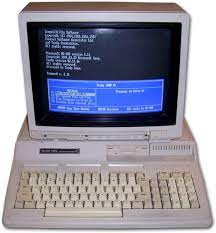
|
Released:1987
Class:PC/XT
Form:AIO
CPU:i8088 at 7.16MHz
ALU:i8087 Optional
RAM:256K-640K
FDD:720K 3.5"
HDD:none
EXP:Plus Card
|
The Tandy 1000 HX was released in 1987 and was the successor to the original 6MHz 1000 EX released the year prior. The 1000 HX introduced the usage of a 3.5" 720K floppy drive in place of the 360K DSDD 5.25" drives of all prior models. CPU speed was bumped up to 7.16MHz with software switchable to slow down to the original 4.77MHz of the original 1000 + IBM PC/PC Jr/XT. It was also one of the first Tandy 1000 models to feature MS-DOS in ROM. It shipped with MS-DOS 2.11 (in ROM), and Deskmate II.
Another fine specimen, and one that might actually prevent some headaches if you want to use floppy diskettes. All you need is some scotch tape and you can convert a 1.44M to a 720K and format it as such. However, this machine does have a particular drawback in that you may have to struggle against MS-DOS in ROM on it. This was a cool feature at the time but a notorious PITA for some people who are wanting to run a later and more capable MS-DOS installation (I run 6.22 on my 1000A for example), which may be required for some software. however, that said, it's an 8088, it has the PC Jr Enhanced video, and it has the 3-voice sound, so it's not a bad machine, just a tricky one from what I understand.
|
Tandy 1000 TX
|
Released:1987
Class:XT/286
Form:PC Desktop, 5-slot
CPU:i80286 @6/8MHz
ALU:i80287 Optional?
RAM:640K, expandable to 768K (for video)
FDD:3.5" w/ optional 5.25"
HDD:Optional 20MB HDD (MFM)
EXP:5x ISA Slots
|
The Tandy 1000 TX was released in 1987 as the deluxe model. It was pretty much the same as the 1000SX except a higher memory ceiling, a 286 CPU, and it came with a 3.5" floppy drive (probalby 720K) Standard. A 5.25" floppy and 20MB MFM Hard Disk were optional. It was the last version of the Tandy 1000 to use this older, more rounded, less as fancy case-style. The 1000 TX shipped with MS-DOS 3.22 for the Tandy 1000 TX, Deskmate II, and GW-BASIC.
If you are looking to consolidate more, you might be able to eek XT-era out of this slow enough to be happy, and 286-era just fast enough to be happy. So this might be another really good early DOS games candidate. However, if you are looking for a killer, monster 286 system, this ain't it. See, this is what we called an XT/286 system. Basically, a IBM XT Clone (or a PC Jr clone in this case) with a 286 chip in it. That basically just makes it a very fast XT system. Nothing wrong with that, just that it might be too fast for some people and too slow for others. Like I say here Your Mileage May Vary (YMMV). To me this is one I'd pass up because I tend to personally prefer full-blown AT 286 systems as I feel the 286-era was a real underdog that was very underappreciated.
|
Tandy 1000 SL
|
Released:1988
Class:PC/XT
Form:Desktop, Low-Profile
CPU:i8086 @8MHz
ALU:i8087 Optional?
RAM:384K-640K
FDD:5.25" 360K DSDD
HDD:XT-IDE Inerface
EXP:ISA x5
|
The Tandy 1000 SL was one of two in the second generation line released in 1988. It was sold alongside the previous TX and along side it's more upgraded sister, the 1000 SL/2 (below). Tandy redesigned the case. What differs the SL from the SL/2 is that the SL came with a 360K DSDD Floppy Drive standard, with a second floppy in 360K or 720K as an option. It also had a hard drive option as well in xT-IDE format, usually a Connor Peripheral's IDE disk with a stepper head mechanism. Otherwise, the SL was functionally similiar to the SL/2. It shipped out with the later, fancier version of Deskmate, as well as MS-DOS 3.x for the Tandy 1000 SL series.
The SL is a fine system. It'd be a good system for someone who wants a machine that handles games in that 1983-1990 era fairly well. With a V30 it could be a real beast in just the right middle road. It's also more common than the older models these days and seems a hair more affordable, though keyboards seem to be difficult to track down (as with any Tandy 1000). The only concern is that XT-IDE interface interfering with a more modern option, like the seemingly ironically named OpenSource Xt-IDE card.
|
Tandy 1000 SL/2
|
Released:1988
Class:PC/XT
Form:Desktop, Low-Profile
CPU:i8086 @8MHz
ALU:i8087 Optional
RAM:512K-640K
FDD:3.5" 720K DSDD
HDD:XT-IDE Interface
EXP:ISA x5
|
The Tandy 1000 SL/2 was the second in the second generation of Tandy 1000 PCs - the SL series. This version differed visibly from the SL in that it had a 3.5" 720K Floppy drive standard instead of a 5.25" 360K. It also had a much higher base-memory option from the regular SL in that it came with 512KB stock, but still topped out at 640K. It shipped out with the later, fancier version of Deskmate, as well as MS-DOS 3.x for the Tandy 1000 SL series.
Another fine choice in the lot but basically an original SL with a 3.5" drive in the front instead of a 5.25" drive. Still what I said about the SL stands. Throw in an 8-bit compatible Ethernet Card and an Xt-IDE card with a nice capacious HDD and you have a nice 80's gaming rig that probably won't break the bank too hard.
|
Tandy 1000 TL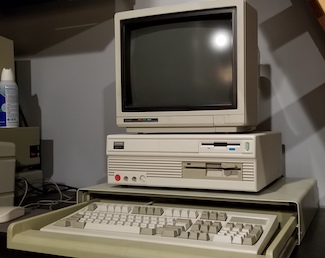
|
Released:1988
Class:XT/286
Form:T1000 TL Desktop
CPU:Intel 80286 @ 8MHz
ALU:Co-PRocessor Optional
RAM:640K-768K
FDD:3.5" 720K
HDD:n/a
EXP:5x ISA
|
The Tandy 1000 TL was an update to the original SL Series, now running a 286 CPU, but still with 8-bit slots, it was basically a 286/XT. This + the TL/2 and TL/3 all used the same chassis so they look identical except for the badging and the motherboards. This version lacks the built-in XT-IDE interface the other 1000 TL-series machines have. It also featured the new "Tandy Video II" system which was an updated version of the Enhanced CGA compatible system from the PC Jr. It also featured a DAC in the sound circuit allowing for digital 8-bit audio to be played. These models shipped with a version of MS-DOS 3 and Deskmate - the later GUI Version. The easiest way to tell if the badge is not availiable is to open the case and see if there are 5x ISA Slots - as the other two models sacrifice the other ISA slot for an IDE Controller.
The 1000TL might be your best bet of the TL series. It's 286, it's 8MHz, it's on an 8-bit bus, it seems to be more common than the SL or RL series, and more expandable than the RL series. It also seems to be more common than the original 1000A/HD/SX/EX/HX models as well. Since you have 5 ISA Slots, would be a good candidate to put a XT-IDE controller and a nice large HDD in with a bunch of SCI and AGI Sierra titles on the drive, and an Ethernet card so you could go surfing and downloading on broadband these days. Not a bad machine, and my personal best of the TL lot because the stripped-down nature offers some expandability the other models XT-IDE controller might give some difficulty to depending on how it's disabled.
|
Tandy 1000 TL/2
|
Released:1989
Class:PC/XT
Form:T1000 TL Desktop
CPU:80286 @8MHz
ALU:Optional
RAM:640K-768K
FDD:720K 3.5"
HDD:Optional, XT-IDE
EXP:5x ISA
|
The 1000 TL/2 was an update to the original TL in the minor addition of an XT-IDE interface on the motherboard. Otherwise, all features and general design were identical to the original Tandy 1000 TL. It also shipped with DOS 3.x on it for the Tandy 1000 TL-series and a newer version of Deskmate.
To me, I really don't see any real benefit to this system today. It's big deal at the time was having a hard drive installed, and a built-in controller for one (pon a TL you'd need to install a card and a drive). I recall having one of these at one time and it was also still a pain to find the Keyboard as a regular PS/2 keyboard would not work (wrong scancodes). A decent system, yes, but not one of my higher choices given my experiences with it. But that said, I only owned one for a hot minute in 2004.
|
Tandy 1000 TL/3
|
Released:1989
Class:XT/286
Form:T1000 TL Desktop
CPU:80286 @10MHz
ALU:Optional
RAM:640K-768K
FDD:1.44M 3.5"
HDD:none
EXP:5x ISA
|
The Tandy 1000 TL/3 was the last in the 1000 TL-series and saw a tiny speed boost from 8MHz to 10MHz (2MHz faster). HOwever it's otherwise idential to the TL/2, except one other change. This one was available from the factory with either a 720K Floppy Drive or a 1.44MB High Density Floppy drive, though most examples left the factory with the 720K Floppy. The 1000 TL/3 was replaced by the RL Series that same year, which would be the last series of Tandy 1000 system.
The TL/3 was another XT/286 system by Tandy. That said, this is one of the better choices out of the 286 systems if you want what's basically a "Fast XT". It also offers the benefits of the front mounted controls and audio management that the TX and older did not have, as well as a fast 10MHz CPU that can be down-clocked to 5MHz. If you want a full featured 286 with Tandy 1000 capabilities, then this would be your machine. That said, you are limited to 768K RAM unfortunatley, and an 8-bit bus, so it's not the fastest 286 you could get your hands on, but it might be a little better than an 8088 or 8086 system from a compatibility standpoint given the extra instructions the 286 offers.
|
Tandy 1000 RL & RL/HD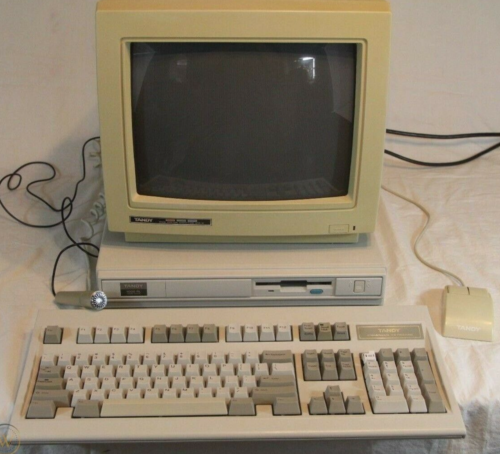
|
Released:1990
Class:XT/PC Jr. Enh
Form:Slimline Desktop
CPU:i8086 @9.56MHz
ALU:Optional
RAM:512K-768K
FDD:720KB 3.5" Floppy
HDD:20MB XT-IDE (in the RL/HD Model)
EXP:1x ISA Slot
|
The Tandy 1000 RL was the last fully XT Tandy 1000 model. Released around 1989-1990, this was the "budget model" of this last bastion of the product line. It featured a new slimline case roughly half the size of the Previous TL and SL models. It was severely limited in expansion by having only one ISA Slot and only one hard disk option available in the special RL/HD model. The IDE interface continued the trend of the XT-IDE interface incompatible with modern ATA drives. The RL was a late-comer to the party and was just around that time where the 386 and 486 PCs were starting to dominate the market, and people started to move to VGA cards and SoundBlaster audio on their PCs. This was also the last model to have the Tandy Video II PC Jr derived standard. MS-DOS and a portion of Deskmate was stored in ROM on the computer so it was basically "instant on", however this provided headaches for someone if they wanted to upgrade the operating system.
The 1000 RL was the last XT, and I'd suggest it only to someone who wants a 1000 that fits in a tiny space, or has a pressboard IKEA desk that can't handle the weight of vintage 80's x86 aweomeness. It's small, it's light, if you get lucky and find an XT-IDE HDD, you might actually be able to use it a lot like my 1000A. The only problem I see with this system is that you are limited to one ISA slot, so you'd have to choose between a more compatible hard disk controller, and an ethernet card.
|
Tandy 1000 RLX
|
Released:1990
Class:XT/286
Form:Slimline Desktop
CPU:80286 @10Mhz
ALU:Optional
RAM:640K-1024K(1MB)
FDD:1.44MB 3.5" HD
HDD:20, 30, or 40MB XT-IDE
EXP:
|
The Tandy 1000 RLX was the last 286 version of the Tandy 1000. It was identical physcially to the RL and RL/HD except this version offered 3 different hard disk options, and was the first Tandy 1000 capable of running with an entire 1024K Memory. It also was the first one to dump the then already ancient CGA derived PC Jr TGA video for the new standard, VGA. The machine was still considered an XT/286 machine because it only had one 8-bit ISA slot like a Pre-286 XT system would have, heavily limiting what could be upgraded with this machine.
Basically it's a micro-sized 1000TX. At the time, this would have been an awesome machine, but today for retro-gaming, for some people who are Tandy purists, the VGA hurts, but for others, it's a real benefit because you can have your 16-color PC JR Enhanced Cake and eat it in EGA 320x200 too. The only problem is that single 8-bit ISA slot. This means the best thing to put in there is some kind of 8-bit compatible ISA Ethernet adapter for networking and that's about it. That said, it would be a good space saver for someone tight on space who wants something that can run games up to the 1991 era. But that XT-IDE interface could bring on some headaches being as compatible drives are impossible to find in 2022.
|
Tandy 1000 RSX
|
Released:1991
Class:386 AT
Form:Slimline Desktop
CPU:Intel 386 SX-25
ALU:optional
RAM:1MB-9MB
FDD:1.44MB 3.5" HD
HDD:54MB AT-IDE, 504MB BIOS Limit
EXP:2x 16-bit ISA
|
The Tandy 1000 RSX was Tandy's swan song before moving to the 2500/3000 and Sensation series PC's. It'd only be a few more years before Tandy Computer would be sold off to AST Research and start to fade into history. The RSX was the only 386 based 1000 System, and probably the closest thing to a "standard" PC the 1000 line ever was. It still looks much the same as the prvious examples except the obvious 2 ISA Slots in back of the system. It also is the most expandable having AT-IDE and having the capability to have more than 1MB (1024K) on board. It was after this model Tandy discontinued the series and replaced it with those I mentioned.
The Tandy 1000 RSX might be a good system for someone whose interest in DOS gaming drops off at 1994 at the latest. There's nothing wrong with a 386 SX and you could possibly dig up one of those rare IBM "Blue Lightning" BLX4 upgrades for it which makes it effectively a 486 DX-2 from performance specs. It could bridge the gap pretty well between all three eras, but I can't really say for sure. I'm basing all this on my own Compaq Deskpro 386s/20 which has a Blue Lightning chip in it. A RSX with 9MB of RAM and a Blue Lightning an 387 would be quite a beast to behold, especially with an 8GB HDD with Maxblast on it. With a upgrade video card that's fast, say a TSENG ET-4000, you could possibly run The 7th Guest on this thing. But that said, these are one of the rarest 1000's you'll ever come across because they did not sell too well. By that point, most people had moved on from Tandy and started looking to small, independant, local system builders to make their 386 and 486 computers. Anyone ever notice how that era was so devoid of brand names except Packard Bell (for their cheapness) and IBM (because they were the originators). I think one of Tandy's biggest mistakes in the industry was clinging onto that aging PC Jr standard well beyond the point where it was usable. In 1984-1988 it was cool and really put them head and neck above the rest, but in 1991?!? They would have been better off with a generic 386SX clone and maybe add a powerful 386 DX and 486 DX to their product line (which they tried to do with the 2500/3000/Sensation models).
|
|

